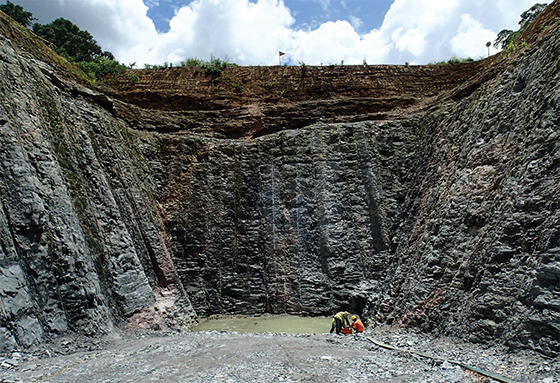ASX-listed Newfield Resources has reported excellent progress on its Tongo diamond project (Tongo Mine Development) in eastern Sierra Leone. The drilling, blasting and excavation of the boxcut which will give access to the planned underground mine has been completed and Newfield has also concluded a lease agreement for mining equipment. In addition, a new drilling programme has begun with the aim of expanding the project’s resource.
The Tongo Mine Development combines kimberlite dyke-hosted diamond resources on two adjacent mining licences that cover over 134 km2 and host 11 identified diamondiferous kimberlites. It is subject to a Tribute Mining Agreement between the two mining licence holders, these being Newfield’s subsidiary company, Sierra Diamonds Limited, and Octéa Mining’s subsidiary company, Tonguma Limited. Newfield has full management and operating control of the combined Tongo Mine Development.

Boxcut development at the Tongo diamond project.
Only four of the identified kimberlites are incorporated in the current JORC-compliant indicated and inferred diamond resource estimate of 7,4 million carats. Of this resource, a 1,1 million carat probable reserve has been declared for just two of the kimberlites, Kundu and Lando.
A FEED study on Tongo was commissioned by Newfield following its acquisition of Stellar Diamonds in early 2018. The study was completed by Paradigm Project Management (PPM) of Johannesburg in April 2019. Other key contributors to components of the FEED Study were MPH Consulting, Z-Star Mineral Resource Consultants, SRK Consulting and Datamine.
Based on the reserves only model from the FEED study, the Tongo Mine Development is expected to deliver a mining operation with an initial eight-year life. Total diamond production of 1,1 Mct is forecast with a peak diamond production of 260 000 carats in Year 5. A US$222/ct realised price is expected while the forecast unit opex is US$115/ct. The estimated capex for the project is approximately US$29 million.
Mining will be exclusively by underground methods with single portal access to Kundu and Lando being provided from the boxcut, which is located approximately midway between the two kimberlites. The selected mining method is traditional shrinkage stoping (with an 85 cm stoping width), a method commonly used in similar kimberlite dyke mining operations in South Africa.
The single decline to Kundu and Lando will commence with a 6 m x 4 m portal entry and continue at the decline slope angle of 8 degrees for a distance of 149 m, whereafter it will split into two separate declines of 4 m x 4 m dimensions towards Kundu and Lando respectively. The joint decline will take approximately four months to develop and equip before the split. Thereafter, the 4 m x 4 m declines will continue at a slope of 8 degrees and spiral down to Level 5 (48 masl) which is the basis of the current mine plan.
To complete the boxcut excavation, five blasts were undertaken and some 52 000 m3 of blasted granite have been removed to the waste dump stockpile, where Newfield has recently established a crushing plant to produce aggregate for the mine construction. The boxcut is now at the elevation required based on the geotechnical studies to ensure that the portal entry for the decline to access both the Kundu and Lando kimberlites can be drilled and blasted.
A consulting rock engineer has visited the site and undertaken a geotechnical study to make recommendations on the required support for the boxcut and the initial development of the portal and decline to ensure a safe working environment.
Newfield also reports it has entered into a finance lease agreement with ASX-listed BauMart Holdings for the lease of mining equipment that is required for the initial stages of the Tongo underground mine development. The equipment comprises two drill rig jumbos, two haul trucks and two LHD loaders with an aggregate value of US$2,8 million. Procurement of capital items to support the boxcut and commence the portal opening and decline development will now be made, in advance of the expected arrival of the rock drills, loaders and haul trucks in late December.
In respect of processing, the FEED study envisaged using the former Koidu 50 t/h production plant, which Newfield acquired from Octéa Mining as part of the Tribute Mining Agreement. As part of an optimisation programme following the FEED study, Newfield assessed options for potential rapid expansion of processing capacity and diamond production rates. This review included weighing a single enlarged plant design against planned refurbishment of the existing 50 t/h plant coupled with investment in a standalone 25 t/h processing plant at the Tongo Dyke-1 site. The outcome of this review is that it is more efficient, in both capital investment and operating terms, to implement a modular 100 t/h plant design from the outset of mine development.
Various key components of the 50 t/h plant can be used in the development of the 100 t/h plant. The aggregate capital investment with the expanded capacity is only marginally higher than the original 50 t/h refurbishment approach. The detailed design of the 100 t/h plant has been completed and earthworks excavations for plant civils have begun.
As part of the ongoing resource development work at Tongo, Newfield has commenced further drilling and diamond assays on the Panguma kimberlite, which is located to the west of the Kundu and Lando kimberlites. The objective is to declare an initial resource for Panguma, which will also increase the global Tongo Mine Development resource.
A drilling programme at Panguma is currently in progress using an in-house diamond drill rig and is providing a better density of drilling along strike of the kimberlite, and thus a higher confidence geological model. So far eight holes (for 574 m) have been drilled, with all holes intersecting the kimberlite. It is envisaged that a further four holes will be drilled and then samples of kimberlite core will be sent to the Saskatchewan Research Council (SRC) for further microdiamond analysis and grade estimation.
Two separate samples of the Panguma kimberlite, totalling 329,95 kg, were collected as part of the current work programme and were consigned to the SRC for caustic fusion (microdiamond analysis). Combined, these samples yielded 962 diamonds, weighing 1,69 carats. Some 28 diamonds were classified as >0,85 mm in size, with the largest stone measuring 5,5 mm x 4,7 mm x 3,0 mm (0,79 carats in weight).
Commenting on the progress at Tongo, Newfield Executive Director Karl Smithson noted that the boxcut has been completed with zero safety incidents. “Work is now focused on providing the necessary support of the boxcut and shaping of the haul road to attain the right angle of entry into the decline,” he said. “With the recent signing of the lease agreement for the mining equipment, which is due to arrive on site at the end of this year, we look forward to commencing the opening of the portal and driving down the decline towards the Kundu and Lando ore reserves from January 2020.
“As part of the mine design optimisation work, it became clear that an opportunity exists to develop the Tongo D-1 kimberlite from 2023 in parallel with planned mining of the Kundu and Lando kimberlites. The decision has therefore been taken to adopt a plant design enabling rapid modular expansion from 50 t/h to a nameplate 100 t/h capacity. This provides the potential for significantly expanded production rates from 2023 and also delivers the flexibility to further increase production from existing and other kimberlites that are not yet in the broader mine plan.”
Photos courtesy of Newfield Resources





















